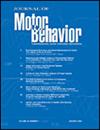Age-Related Development of Bilateral Coordination of the Upper Limbs in Children and Adolescents.
IF 1.2
4区 心理学
Q4 NEUROSCIENCES
引用次数: 0
Abstract
Bilateral coordination of the upper limbs (UL) is important for activities of daily living and physical activities. Motor coordination improves from childhood through adolescence. However, age-coordination trajectories for bilateral UL movements are not well-established, and it is unclear if bimanual coordination develops slower than unilateral coordination. In this study we examined age-related changes in UL coordination from childhood to late adolescence. Typically-developing children (N = 29, aged 7-17 years) performed unilateral and bilateral, antiphase cycling tasks with their ULs. Variations in cycling velocity and interlimb phase errors were computed as measures of coordination. Linear regression was used to examine age-coordination effects. Given the sensorimotor processing for bilateral movements and gradual development of the corpus callosum, we hypothesized different relationships between age and coordination for bilateral and unilateral movements. Results showed UL coordination was significantly related to age, where coordination was better in older compared to younger children (p < 0.001); however, there were similar significant effects for unilateral movements. Differences in unilateral and bilateral coordination were not significantly explained by biological sex, although power to detect sex differences was low. We conclude that bilateral and unilateral UL coordination are age-dependent; each improves at similar rates through childhood and adolescence.儿童和青少年双侧上肢协调能力的发展与年龄有关。
双侧上肢(UL)的协调对于日常生活和体育活动非常重要。从童年到青春期,运动协调能力都在不断提高。然而,双侧上肢运动的年龄协调轨迹尚未得到很好的确定,双侧协调的发展速度是否慢于单侧协调尚不清楚。在这项研究中,我们考察了从儿童期到青春期晚期UL协调能力的年龄相关变化。发育正常的儿童(29 人,7-17 岁)用他们的 UL 完成了单侧和双侧反相循环任务。计算骑行速度和肢间相位误差的变化作为协调性的测量指标。线性回归用于检验年龄对协调性的影响。鉴于双侧运动的感觉运动处理和胼胝体的逐渐发育,我们假设双侧和单侧运动的年龄与协调性之间存在不同的关系。结果表明,UL 协调性与年龄有显著关系,年龄较大的儿童比年龄较小的儿童协调性更好(p < 0.001);然而,单侧运动也有类似的显著影响。单侧和双侧协调性的差异与生理性别无明显关系,但检测性别差异的能力较低。我们的结论是,UL 的双侧和单侧协调性与年龄有关;两者在儿童期和青春期的改善速度相似。
本文章由计算机程序翻译,如有差异,请以英文原文为准。
求助全文
约1分钟内获得全文
求助全文
来源期刊

Journal of Motor Behavior
医学-神经科学
CiteScore
3.10
自引率
0.00%
发文量
39
审稿时长
>12 weeks
期刊介绍:
The Journal of Motor Behavior, a multidisciplinary journal of movement neuroscience, publishes articles that contribute to a basic understanding of motor control. Articles from different disciplinary perspectives and levels of analysis are encouraged, including neurophysiological, biomechanical, electrophysiological, psychological, mathematical and physical, and clinical approaches. Applied studies are acceptable only to the extent that they provide a significant contribution to a basic issue in motor control. Of special interest to the journal are those articles that attempt to bridge insights from different disciplinary perspectives to infer processes underlying motor control. Those approaches may embrace postural, locomotive, and manipulative aspects of motor functions, as well as coordination of speech articulators and eye movements. Articles dealing with analytical techniques and mathematical modeling are welcome.
 求助内容:
求助内容: 应助结果提醒方式:
应助结果提醒方式:


